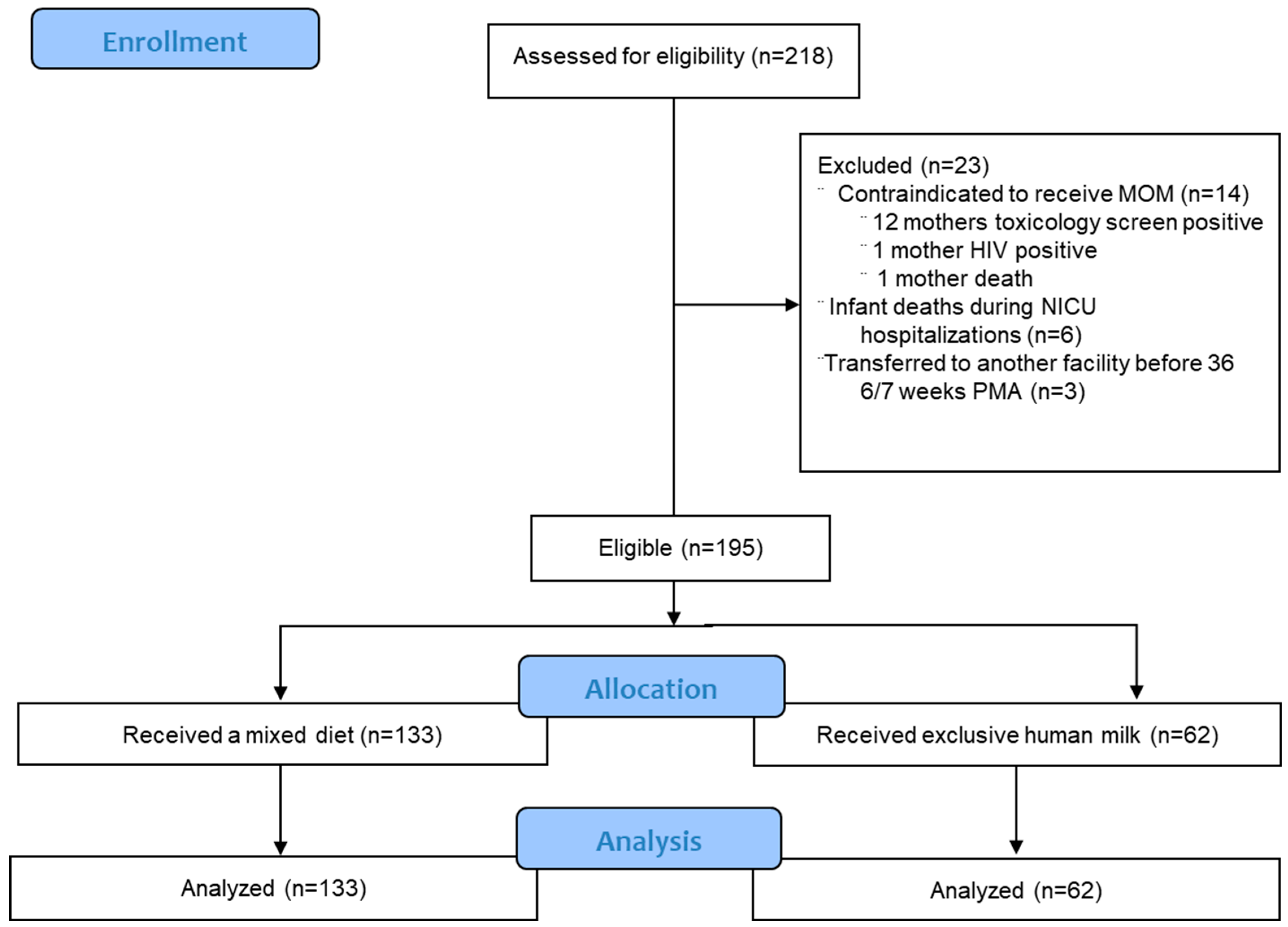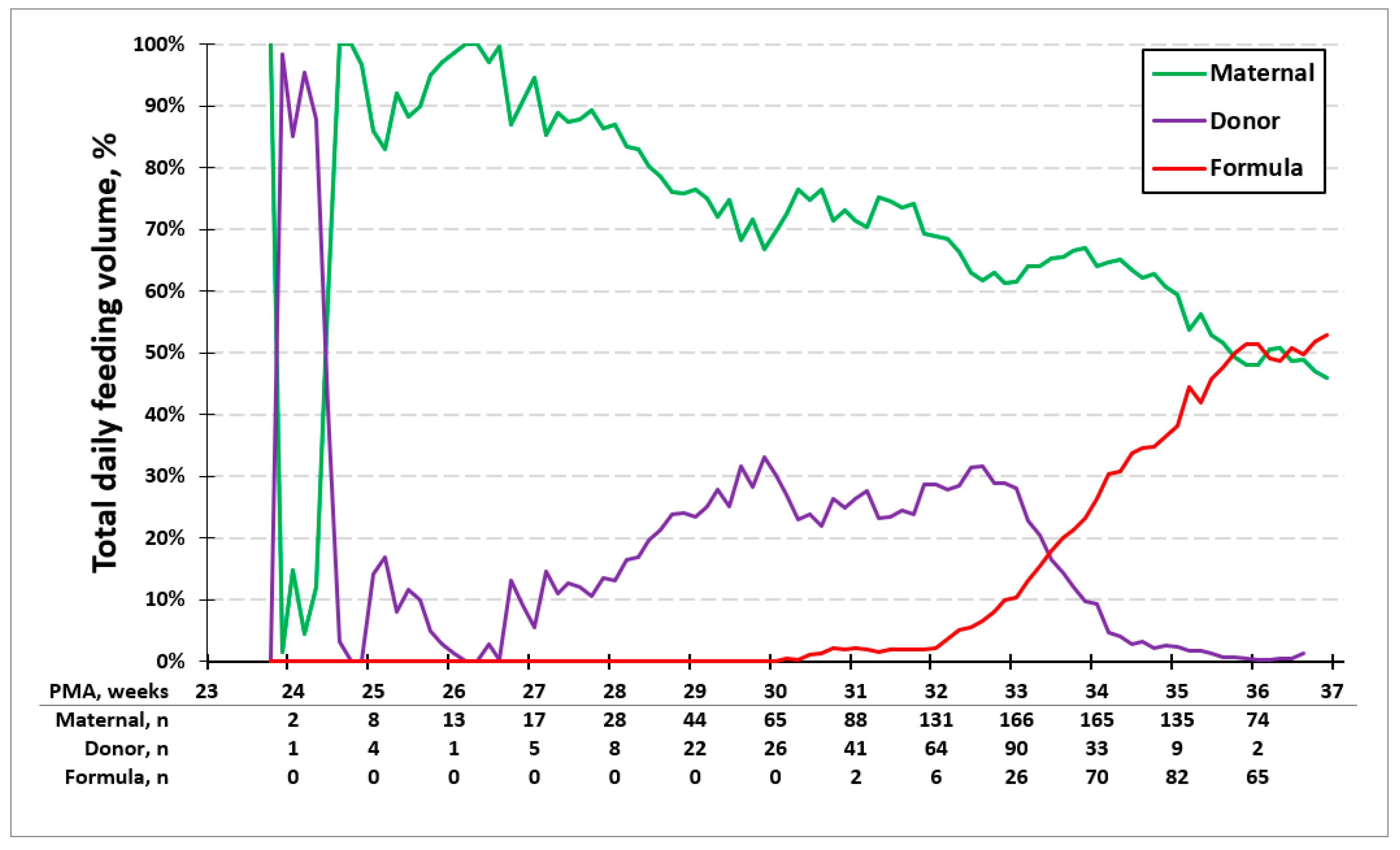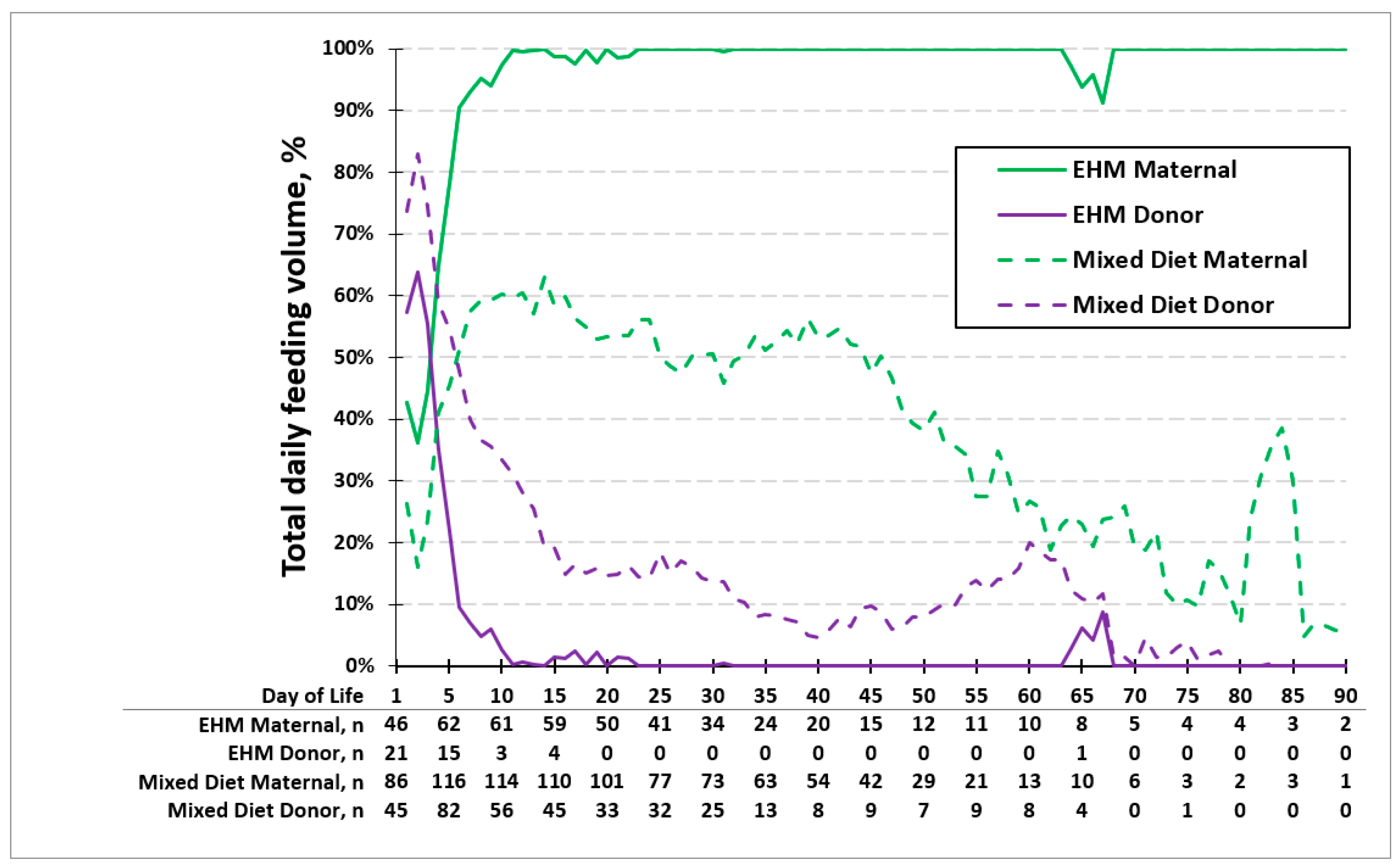Type and Volume of Milk Intake in Premature Infants <33 Weeks Gestational Age in the Neonatal Intensive Care Unit
Abstract
1. Introduction
2. Materials and Methods
3. Results
4. Discussion
Supplementary Materials
Author Contributions
Funding
Institutional Review Board Statement
Informed Consent Statement
Data Availability Statement
Acknowledgments
Conflicts of Interest
References
- Gartner, L.M.; Morton, J.; Lawrence, R.A.; Naylor, A.J.; O’Hare, D.; Schanler, R.J.; Eidelman, A.I.; American Academy of Pediatrics Section on Breastfeeding. Breastfeeding and the use of human milk. Pediatrics 2005, 115, 496–506. [Google Scholar] [CrossRef] [PubMed]
- World Health Organization. WHO Recommendations for Care of the Preterm or Low-Birth-Weight Infant; WHO Guidelines Approved by the Guidelines Review Committee; World Health Organization: Geneva, Switzerland, 2022.
- Vohr, B.R.; Poindexter, B.B.; Dusick, A.M.; McKinley, L.T.; Higgins, R.D.; Langer, J.C.; Poole, W.K.; National Institute of Child Health; Human Development National Research Network. Persistent beneficial effects of breast milk ingested in the neonatal intensive care unit on outcomes of extremely low birth weight infants at 30 months of age. Pediatrics 2007, 120, e953–e959. [Google Scholar] [CrossRef] [PubMed]
- Sullivan, S.; Schanler, R.J.; Kim, J.H.; Patel, A.L.; Trawoger, R.; Kiechl-Kohlendorfer, U.; Chan, G.M.; Blanco, C.L.; Abrams, S.; Cotten, C.M.; et al. An exclusively human milk-based diet is associated with a lower rate of necrotizing enterocolitis than a diet of human milk and bovine milk-based products. J. Pediatr. 2010, 156, 562–567.e561. [Google Scholar] [CrossRef]
- Schanler, R.J.; Shulman, R.J.; Lau, C. Feeding strategies for premature infants: Beneficial outcomes of feeding fortified human milk versus preterm formula. Pediatrics 1999, 103, 1150–1157. [Google Scholar] [CrossRef]
- Corpeleijn, W.E.; Kouwenhoven, S.M.; Paap, M.C.; van Vliet, I.; Scheerder, I.; Muizer, Y.; Helder, O.K.; van Goudoever, J.B.; Vermeulen, M.J. Intake of own mother’s milk during the first days of life is associated with decreased morbidity and mortality in very low birth weight infants during the first 60 days of life. Neonatology 2012, 102, 276–281. [Google Scholar] [CrossRef] [PubMed]
- Hylander, M.A.; Strobino, D.M.; Pezzullo, J.C.; Dhanireddy, R. Association of human milk feedings with a reduction in retinopathy of prematurity among very low birthweight infants. J. Perinatol. Off. J. Calif. Perinat. Assoc. 2001, 21, 356–362. [Google Scholar] [CrossRef]
- Patel, A.L.; Johnson, T.J.; Robin, B.; Bigger, H.R.; Buchanan, A.; Christian, E.; Nandhan, V.; Shroff, A.; Schoeny, M.; Engstrom, J.L.; et al. Influence of own mother’s milk on bronchopulmonary dysplasia and costs. Arch. Dis. Child. Fetal Neonatal Ed. 2017, 102, F256–F261. [Google Scholar] [CrossRef]
- Uberos, J.; Sanchez-Ruiz, I.; Fernandez-Marin, E.; Ruiz-Lopez, A.; Cubero-Millan, I.; Campos-Martinez, A. Breast-feeding as protective factor against bronchopulmonary dysplasia in preterm infants. Br. J. Nutr. 2024, 131, 1405–1412. [Google Scholar] [CrossRef]
- Xu, Y.; Yu, Z.; Li, Q.; Zhou, J.; Yin, X.; Ma, Y.; Yin, Y.; Jiang, S.; Zhu, R.; Wu, Y.; et al. Dose-dependent effect of human milk on Bronchopulmonary dysplasia in very low birth weight infants. BMC Pediatr. 2020, 20, 522. [Google Scholar] [CrossRef]
- Correani, A.; Spagnoli, C.; Lanciotti, L.; Monachesi, C.; Antognoli, L.; De Angelis, F.; Biagetti, C.; Burattini, I.; Carnielli, V. Mother’s own milk and bronchopulmonary dysplasia in appropriate for gestational age preterm infants. Eur. J. Clin. Nutr. 2024, 78, 703–708. [Google Scholar] [CrossRef]
- Fewtrell, M.S.; Kennedy, K.; Ahluwalia, J.S.; Nicholl, R.; Lucas, A.; Burton, P. Predictors of expressed breast milk volume in mothers expressing milk for their preterm infant. Arch. Dis. Child. Fetal Neonatal Ed. 2016, 101, F502–F506. [Google Scholar] [CrossRef] [PubMed]
- Hill, P.D.; Aldag, J.C.; Chatterton, R.T.; Zinaman, M. Psychological distress and milk volume in lactating mothers. West. J. Nurs. Res. 2005, 27, 676–693. [Google Scholar] [CrossRef]
- Kulkarni, D.; Murki, S.; Pawale, D.; Jena, S.; Sharma, D.; Vardhelli, V.; Kallem, V.; Bashir, T.; Naik, V.; Kiran, S. Enablers and barriers for enteral feeding with mother;s own milk in preterm very low birth weight infants in a tertiary care neonatal intensive care unit. Turk. J. Pediatr. 2021, 63, 564–574. [Google Scholar] [CrossRef] [PubMed]
- Patel, A.L.; Johnson, T.J.; Meier, P.P. Racial and socioeconomic disparities in breast milk feedings in US neonatal intensive care units. Pediatr. Res. 2021, 89, 344–352. [Google Scholar] [CrossRef]
- Hoban, R.; Bigger, H.; Patel, A.L.; Rossman, B.; Fogg, L.F.; Meier, P. Goals for Human Milk Feeding in Mothers of Very Low Birth Weight Infants: How Do Goals Change and Are They Achieved During the NICU Hospitalization? Breastfeed. Med. 2015, 10, 305–311. [Google Scholar] [CrossRef] [PubMed]
- Meier, P.P.; Johnson, T.J.; Patel, A.L.; Rossman, B. Evidence-Based Methods That Promote Human Milk Feeding of Preterm Infants: An Expert Review. Clin. Perinatol. 2017, 44, 1–22. [Google Scholar] [CrossRef]
- Dharel, D.; Singhal, N.; Wood, C.; Cieslak, Z.; Bacchini, F.; Shah, P.S.; Ye, X.Y.; Alshaikh, B.; Canadian Neonatal Network; Canadian Preterm Birth Network (CPTBN) Investigators. Rates and Determinants of Mother’s Own Milk Feeding in Infants Born Very Preterm. J. Pediatr. 2021, 236, 21–27. [Google Scholar] [CrossRef]
- Davanzo, R.; Monasta, L.; Ronfani, L.; Brovedani, P.; Demarini, S.; Breastfeeding in Neonatal Intensive Care Unit Study Group. Breastfeeding at NICU discharge: A multicenter Italian study. J. Hum. Lact. 2013, 29, 374–380. [Google Scholar] [CrossRef]
- Cabrera Lafuente, M.; Montes Bueno, M.T.; Pastrana, N.; Segovia, C.; Madero Jarabo, R.; Martin, C.R.; Omenaca Teres, F.; Saenz de Pipaon Marcos, M. A prospective analysis of intake and composition of mother’s own milk in preterm newborns less than 32 weeks’ gestational age. J. Perinat. Med. 2018, 47, 106–113. [Google Scholar] [CrossRef]
- Oddie, S.J.; Young, L.; McGuire, W. Slow advancement of enteral feed volumes to prevent necrotising enterocolitis in very low birth weight infants. Cochrane Database Syst. Rev. 2017, 8, CD001241. [Google Scholar] [CrossRef]
- Nasuf, A.W.A.; Ojha, S.; Dorling, J. Oropharyngeal colostrum in preventing mortality and morbidity in preterm infants. Cochrane Database Syst. Rev. 2018, 9, CD011921. [Google Scholar] [CrossRef] [PubMed]
- Meier, P.P.; Patel, A.L.; Hoban, R.; Engstrom, J.L. Which breast pump for which mother: An evidence-based approach to individualizing breast pump technology. J. Perinatol. Off. J. Calif. Perinat. Assoc. 2016, 36, 493–499. [Google Scholar] [CrossRef]
- Ikonen, R.; Paavilainen, E.; Helminen, M.; Kaunonen, M. Preterm infants’ mothers’ initiation and frequency of breast milk expression and exclusive use of mother’s breast milk in neonatal intensive care units. J. Clin. Nurs. 2018, 27, e551–e558. [Google Scholar] [CrossRef]
- Sankar, M.N.; Weiner, Y.; Chopra, N.; Kan, P.; Williams, Z.; Lee, H.C. Barriers to optimal breast milk provision in the neonatal intensive care unit. J. Perinatol. Off. J. Calif. Perinat. Assoc. 2022, 42, 1076–1082. [Google Scholar] [CrossRef]
- Parker, L.A.; Sullivan, S.; Krueger, C.; Kelechi, T.; Mueller, M. Effect of early breast milk expression on milk volume and timing of lactogenesis stage II among mothers of very low birth weight infants: A pilot study. J. Perinatol. Off. J. Calif. Perinat. Assoc. 2012, 32, 205–209. [Google Scholar] [CrossRef]
- Murase, M.; Nommsen-Rivers, L.; Morrow, A.L.; Hatsuno, M.; Mizuno, K.; Taki, M.; Miyazawa, T.; Nakano, Y.; Aizawa, M.; Itabashi, K. Predictors of low milk volume among mothers who delivered preterm. J. Hum. Lact. 2014, 30, 425–435. [Google Scholar] [CrossRef]
- Hoban, R.; Bigger, H.; Schoeny, M.; Engstrom, J.; Meier, P.; Patel, A.L. Milk Volume at 2 Weeks Predicts Mother’s Own Milk Feeding at Neonatal Intensive Care Unit Discharge for Very Low Birthweight Infants. Breastfeed. Med. 2018, 13, 135–141. [Google Scholar] [CrossRef]
- Ru, X.; Huang, X.; Feng, Q. Successful Full Lactation Achieved by Mothers of Preterm Infants Using Exclusive Pumping. Front. Pediatr. 2020, 8, 191. [Google Scholar] [CrossRef]
- Mago-Shah, D.D.; Athavale, K.; Fisher, K.; Heyward, E.; Tanaka, D.; Cotten, C.M. Early pumping frequency and coming to volume for mother’s own milk feeding in hospitalized infants. J. Perinatol. Off. J. Calif. Perinat. Assoc. 2023, 43, 629–634. [Google Scholar] [CrossRef]



| Mixed Diet n = 133 | Exclusive Human Milk n = 62 | p Value * | |
|---|---|---|---|
| Birth Gestational Age, weeks | 30.9 (28.7–31.9) | 31.7 (29.6–32.3) | 0.03 |
| Birth Weight, grams | 1420 (1140–1830) | 1634 (1250–1931) | 0.1 |
| Male Gender, % | 62 | 50 | 0.1 |
| Maternal Age, years | 29 (24–35) | 31 (27–34) | 0.3 |
| Parity | 1 (0–2) | 1 (0–2) | 0.09 |
| Maternal Race | 0.9 | ||
| Asian, % | 10 | 10 | |
| Black, % | 3 | 3 | |
| White, % | 85 | 85 | |
| Other, % | 2 | 2 | |
| Maternal Hispanic Ethnicity, % | 77 | 73 | 0.5 |
| Antenatal Steroids, % | 95 | 95 | 0.9 |
| Maternal Pre-Eclampsia, % | 24 | 16 | 0.2 |
| Cesarean Section, % | 67 | 50 | 0.02 |
| Estimated Blood Loss | 800 (400–1000) | 550 (200–800) | 0.01 (0.1) # |
| Cumulative MOM Intake, mL | 4192 (1620–7614) | 7209 (5001–10,754) | <0.001 |
| Cumulative % MOM Intake | 49 (24–78) | 99 (96–100) | <0.001 |
| Mixed Diet n = 133 | Exclusive Human Milk n = 62 | Correlation Coefficient/Odds Ratio (95% CI) | p Value * | Correlation Coefficient/Odds Ratio (95% CI) | Adjusted p Value @ | |
|---|---|---|---|---|---|---|
| Time to First Colostrum, hour | 4.9 (2.7–12.6) | 3.1 (1.4–8.0) | −1.9 (−4.1, 0.3) | 0.091 | −2.5 (−4.4, −0.5) | 0.013 |
| PMA First Breastfeed, weeks | 32.9 (32.3–33.4) | 32.7 (32.1–33.1) | −0.2 (−0.5, 0.2) | 0.351 | 0.0 (−0.4, 0.3) | 0.85 |
| NPO, days | 0 (0–1) | 0 (0–1) | 0.0 (−0.5, 0.5) | 1 | 0.1 (−0.1, 0.2) | 0.565 |
| MOM at Discharge, % § | 78 | 100 | NA | <0.001 | NA | NA |
| Regaining Birth Weight, days | 10 (7–12) | 9 (8–11) | 0.0 (−1.2, 1.2) | 0.967 | 0.0 (−1.2, 1.2) | 0.971 |
| Weight Growth Velocity, g/kg/d | 13.5 (10.9–15.0) | 11.7 (9.5–14.9) | −1.3 (−2.7, 0.0) | 0.054 | −0.6 (−1.6, 0.5) | 0.277 |
| OFC Growth Velocity, cm/wk | 0.78 (0.63–0.89) | 0.73 (0.54–0.88) | 0.0 (−0.1, 0.1) | 0.59 | 0.0 (−0.1, 0.1) | 0.643 |
| Length Growth Velocity, cm/wk | 0.98 (0.80–1.12) | 0.92 (0.70–1.12) | 0.0 (−0.2, 0.1) | 0.586 | 0.0 (−0.1, 0.1) | 0.889 |
| Mixed Diet n = 133 | Exclusive Human Milk n = 62 | Correlation Coefficient/Odds Ratio (95% CI) | p Value * | Correlation Coefficient/Odds Ratio (95% CI) | Adjusted p Value @ | |
|---|---|---|---|---|---|---|
| PMA at Discharge, weeks | 36.6 (35.6–38.0) | 35.6 (35.0–38.0) | −1.0 (−1.9, −0.1) | 0.03 | −0.6 (−1.3, 0.2) | 0.1 |
| Length of Stay, days | 44 (26–64) | 32 (21–50) | −12 (−22, −2) | 0.02 | −9 (−18, 0) | 0.052 |
| Necrotizing Enterocolitis, % | 0.8 | 1.6 | 2.2 (0.1, 35.2) | 0.6 | 2.4 (0.1, 59.9) | 0.6 |
| Severe ROP, % | 3.8 | 4.8 | 1.3 (0.3, 5.6) | 0.7 | 1.3 (0.3, 5.1) | 0.7 |
| Late-Onset Sepsis, % # | 4.5 | 0 | NA | 0.2 | NA | NA |
| Chronic Lung Disease, % | 15.8 | 12.9 | 0.8 (0.3, 1.9) | 0.6 | 1.0 (0.4, 2.8) | 1 |
| Severe Intraventricular Hemorrhage, % | 3.8 | 1.6 | 0.4 (0.0, 3.7) | 0.4 | 0.4 (0.0, 4.2) | 0.4 |
| Survival w/o Major Morbidity, % | 78.2 | 87.1 | 1.9 (0.8, 4.4) | 0.1 | 1.7 (0.7, 4.3) | 0.2 |
Disclaimer/Publisher’s Note: The statements, opinions and data contained in all publications are solely those of the individual author(s) and contributor(s) and not of MDPI and/or the editor(s). MDPI and/or the editor(s) disclaim responsibility for any injury to people or property resulting from any ideas, methods, instructions or products referred to in the content. |
© 2025 by the authors. Licensee MDPI, Basel, Switzerland. This article is an open access article distributed under the terms and conditions of the Creative Commons Attribution (CC BY) license (https://creativecommons.org/licenses/by/4.0/).
Share and Cite
Narasimhan, S.R.; Vallejo, M.; Nudelman, M.; Jegatheesan, P. Type and Volume of Milk Intake in Premature Infants <33 Weeks Gestational Age in the Neonatal Intensive Care Unit. Children 2025, 12, 431. https://doi.org/10.3390/children12040431
Narasimhan SR, Vallejo M, Nudelman M, Jegatheesan P. Type and Volume of Milk Intake in Premature Infants <33 Weeks Gestational Age in the Neonatal Intensive Care Unit. Children. 2025; 12(4):431. https://doi.org/10.3390/children12040431
Chicago/Turabian StyleNarasimhan, Sudha Rani, Maricela Vallejo, Matthew Nudelman, and Priya Jegatheesan. 2025. "Type and Volume of Milk Intake in Premature Infants <33 Weeks Gestational Age in the Neonatal Intensive Care Unit" Children 12, no. 4: 431. https://doi.org/10.3390/children12040431
APA StyleNarasimhan, S. R., Vallejo, M., Nudelman, M., & Jegatheesan, P. (2025). Type and Volume of Milk Intake in Premature Infants <33 Weeks Gestational Age in the Neonatal Intensive Care Unit. Children, 12(4), 431. https://doi.org/10.3390/children12040431





